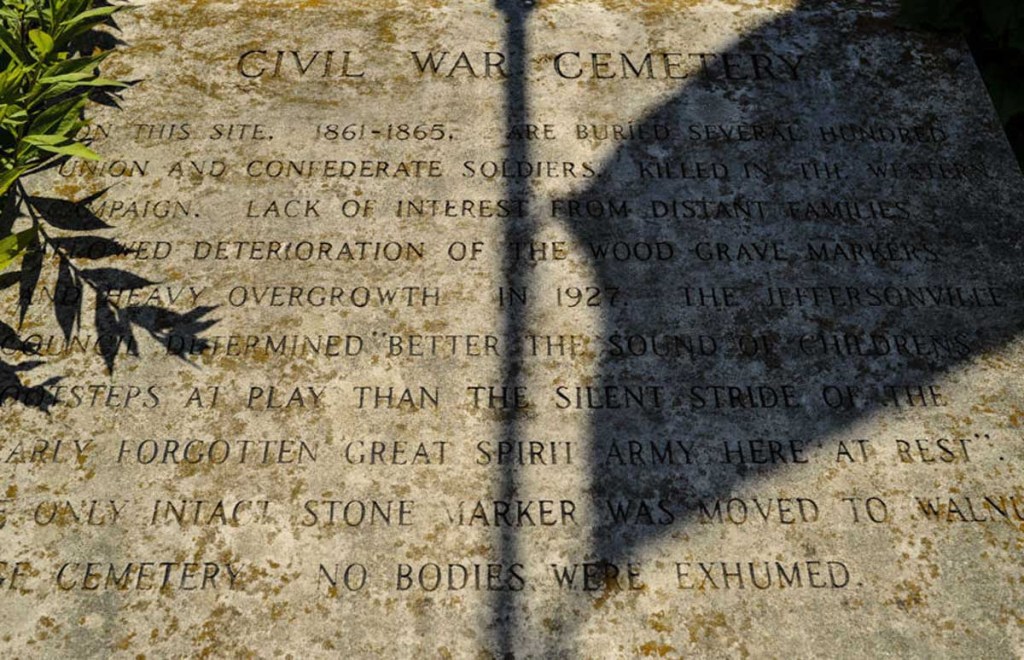In Indiana, a debate over how to mark history
Published 3:53 pm Tuesday, June 14, 2016

- Words etched into the stone marker at Colton Park in Jeffersonville, Indiana, tell the story of forgotten soldiers from the Civil War whose remains are buried beneath the surface in downtown Jeffersonville.
It’s difficult to be sure, but as best as Doris Wyzard can tell, the bones of her distant relative who fought in the Revolutionary War lie in the dirt beneath a park in an historic neighborhood in Jeffersonville, Indiana.
“You can’t pick out individual stones because there’s nothing there,” said Wyzard, a descendent of Richard Pile.
Instead, many graves were marked by wooden posts through the years, with the park serving as a final resting place for any and all in the city — from soldiers on both sides of the Civil War to everyday citizens of Clark County.
“It was the main burying ground for the city of Jeff,” Clark County Historian Jeanne Burke said.
The cemetery holds more than 350 bodies that were never exhumed. The oldest burial Burke was able to find a record of was in 1807. Jeffersonville prohibited any further burials in 1862 per city ordinance.
With a couple of soccer goals and a playground, the only sign today that the park is holy ground for centuries-gone soldiers and townspeople is a stone marker and an American flag.
The placement of that marker is now in jeopardy as Jeffersonville officials move forward with plans for residential developments along the eastern most side of the park.
Many have their opinions on the fate of the Civil War cemetery marker that reads “better the sound of children’s footsteps at play than the silent stride of the nearly forgotten great spirit army here at rest.”
While some would like it relocated behind the homes, others are concerned the monument will become invisible and forgotten.
Such controversies are becoming increasingly common as land near cemeteries becomes more developed, says J.J. Prats, who publishes the Historical Marker Database, a searchable online catalog of historic cemetery markers and plaques.
“It does happen about three or four times a year where the march of progress wants to move (markers),” Prats said. “And if nobody cares, it’s easy for the city road department or whoever to put them in storage while they figure out what to do with them. Then before you know it, 50 years later, they’re still sitting in storage.”
Jeffersonville Mayor Mike Moore, a member of the city’s redevelopment commission heading the project, wants the marker moved farther back on the property.
“The first three words on this marker are ‘on this site,’” Moore told the Jeffersonville, Indiana News and Tribune. “What’s the point of a burial marker? It’s to mark the spot where the burial remains are.”
Prats agreed, saying many markers are inscribed with location-specific wording that can lose its meaning if the marker is moved.
“That often happens,” said Prats, whose database includes information on more than 85,000 markers throughout the United States. “And when it does, nobody cares that it no longer means what it says.”
In Jeffersonville, archaeologists have determined no remains lie on the property up for development. Rather, bones are located on the western half of the park.
“I want it moved back to the site where the burials actually are,” Moore said.
However, that’s not the sentiment expressed by those who live close by.
The Rose Hill Neighborhood Association submitted a letter to Moore, also published in the News and Tribune, asking the mayor to consider moving the stone marker atop an historic railroad piling at Big Four Station.
“Relocation to the parking island will preserve the visibility and viability of the memorial and its inscriptions which remind us all of our history dating back to Civil War battles fought here, and the commitment by the city of Jeffersonville to preserve this historic location with its dedication of the site almost 90 years ago,” the letter states.
Wyzard, who frequents cemeteries as part of her genealogy research, said she’s fine with the marker moving off the property “as long as it’s right along there where the ballpark is.”
“It’s back there where people don’t notice it anyway,” Wyzard said.
As far as the residential developments go? That’s fine, too.
“I don’t believe in the dead dominating the living,” she said. “That’s why I’m for cremation. We’re going to run out of spaces one of these days.”
The Jeffersonville, Indiana News and Tribune contributed to this story.




